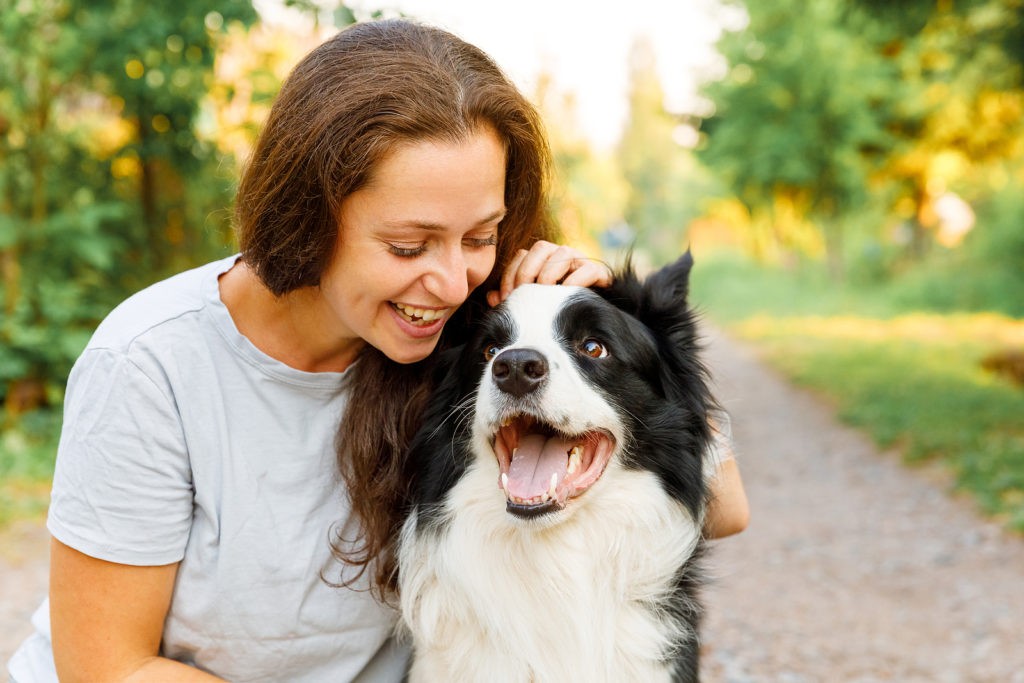Petting a dog is often an instinctive reaction for humans. It’s a common way we interact with our canine companions, but have you ever stopped to consider what your dog actually feels when you reach out to stroke their fur? While it’s a frequent gesture of affection from our side, understanding how dogs perceive and experience petting is key to building a stronger, more trusting relationship. Unlike many animals who may not appreciate touch from different species, dogs have evolved alongside humans and often seek physical contact as a sign of bonding and love.
However, not all petting is created equal, and understanding the nuances of canine communication is vital, especially when interacting with dogs you don’t know well. Let’s explore the science behind why dogs enjoy being petted, where they prefer to be touched, and how to ensure your petting sessions are positive and enjoyable for your furry friend.
 A person gently pets a dog on its head, both appearing relaxed and happy.
A person gently pets a dog on its head, both appearing relaxed and happy.
The Science of Petting: Oxytocin and Canine Connection
Dogs are inherently social animals, and their bond with humans is particularly profound. For many dogs, petting is much more than just a physical sensation; it’s a powerful form of communication and affection from their beloved human companions. Research has illuminated the fascinating neurochemical processes at play when we pet a dog. Studies show that when dogs are petted and receive attention from humans, their brains release oxytocin, often referred to as the “love hormone” or “bonding hormone.” This same hormone is released in humans during social bonding activities, highlighting the deep emotional connection that petting fosters between dogs and their owners.
Interestingly, this heartwarming effect is reciprocal. Petting a dog doesn’t just benefit the canine; it also triggers the release of oxytocin in humans. This mutual release of oxytocin underscores the unique and mutually beneficial relationship we share with dogs, where simple acts of physical affection like petting can significantly enhance emotional well-being for both species.
Decoding Doggy Delight: Where Do Dogs Love to Be Pet?
While each dog is an individual with unique preferences, there are general areas where most dogs tend to enjoy being scratched and petted. Generally, you’ll find that dogs appreciate being scratched on their chest, neck, and shoulders. These areas are often easily accessible and less sensitive, making them ideal starting points for petting, especially with a dog you are just getting to know. Many dogs also enjoy being scratched around their ears or along their back.
If a dog rolls onto its back, presenting its belly, this is often interpreted as an invitation for a belly rub. However, it’s crucial to understand dog body language. While a belly display can signal trust and a desire for interaction, always observe the dog’s overall demeanor. A relaxed posture, soft eyes, and a wagging tail are positive signs. If the dog seems tense or uncomfortable, it’s best to respect their space.
When approaching a new dog, it’s always safest to begin petting in the universally appreciated zones like the chest, neck, and shoulders. As you build familiarity and trust, you can gradually explore other areas, paying close attention to the dog’s reactions to discover their individual preferences.
Body Language and the Leg Shake Reflex
Dog owners often find amusement in the involuntary leg shaking or kicking that sometimes occurs when they scratch their dog in a particular spot. This quirky behavior is a simple physiological reflex, much like the knee-jerk reaction humans experience. When you scratch a dog in just the right area, you stimulate a nerve that triggers an automatic signal to the dog’s leg, causing it to kick.
While this leg-shaking reflex can be entertaining to observe, it’s important to remember that it’s an involuntary response. Some dogs might be startled or confused by this lack of control over their own body. Therefore, while enjoying this peculiar reaction, be mindful of your dog’s comfort and ensure they are not becoming anxious or agitated by the sensation.
Areas to Approach with Caution: Head and Sleep
While we might instinctively reach for a dog’s head to pet them, particularly the top of the head, this isn’t always appreciated by dogs, especially by dogs who are unfamiliar with you. The top of the head can be a vulnerable area for dogs. If they don’t have a strong sense of trust with the person reaching towards them, they may perceive a hand approaching their head as a potential threat. This can lead to feelings of anxiety or discomfort.
Unless you have an established, trusting relationship with a dog and know they are comfortable with head pats, it’s generally kinder to focus your petting on areas where they feel more secure and at ease, such as the chest, shoulders, or neck.
Similarly, while it might be tempting to pet a sleeping dog, it’s generally best to let sleeping dogs lie. Just like humans, dogs can be startled and disoriented when abruptly awakened from sleep. Interrupting a dog’s rest can be unsettling and, in some cases, might even provoke a fearful or defensive reaction, particularly if the dog is easily startled or feels insecure. While some dogs may tolerate or even seem to enjoy gentle petting while drowsy, it’s always respectful to allow them undisturbed rest and approach them for interaction when they are fully awake and alert.
Reading Your Dog’s Petting Preferences: Signs of Enjoyment vs. Discomfort
Understanding how dogs feel when you pet them goes beyond knowing the “right spots.” It’s about learning to “listen” to your dog’s body language and respond accordingly. Dogs communicate their feelings through subtle cues, and observing these signals is crucial for ensuring petting is a positive experience.
Signs a dog is enjoying being petted:
- Relaxed body posture: Loose muscles, relaxed tail (wagging loosely or gently).
- Leaning into your touch: Pressing their body against your hand, seeking more contact.
- Soft eyes: Relaxed gaze, possibly even closing their eyes in contentment.
- Contented sighs or soft vocalizations: Quiet whimpers or groans of pleasure.
- Wagging tail: Generally indicates positive emotion, especially when loose and wagging at a medium height.
Signs a dog is uncomfortable or dislikes being petted:
- Turning away or moving away from your touch: Attempting to create distance.
- Tense muscles: Stiff body posture, rigid tail.
- Lip licking or yawning (when not tired): Often displacement behaviors indicating stress or discomfort.
- Whale eye: Showing the whites of their eyes, a sign of anxiety.
- Growling, snapping, or showing teeth: Clear warning signs to stop and give space.
By paying close attention to these signs, you can tailor your petting to ensure your dog is comfortable and enjoying the interaction. Always prioritize their comfort and stop petting if you observe any signs of discomfort.
Petting as a Tool for Calm and Connection
Beyond being a simple act of affection, petting can be a valuable tool for calming a dog who is feeling anxious, stressed, or upset. Gentle, rhythmic stroking can have a soothing effect and help to reduce the intensity of negative emotions. When using petting to calm a dog, it’s particularly effective to focus on the areas where dogs generally feel most comfortable and receptive, such as the chest, shoulders, and neck.
However, it’s important to recognize that petting alone might not always be sufficient to fully calm a severely distressed dog, depending on the source and intensity of their anxiety. While petting can be a wonderful initial soothing strategy, it should ideally be combined with efforts to identify and remove the underlying cause of the dog’s stress. This might involve moving the dog away from a stressful situation, creating a quieter environment, or providing other forms of comfort and reassurance.
In conclusion, understanding how dogs feel when you pet them is about more than just knowing the right technique. It’s about developing a deeper awareness of canine communication, respecting individual preferences, and using touch as a way to build trust, strengthen your bond, and enhance your dog’s emotional well-being. By approaching petting with sensitivity and awareness, you can transform these interactions into meaningful moments of connection that both you and your canine companion will cherish.
